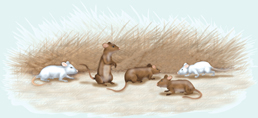Think Critically
Infer Which animal—a cricket or a cat—would you expect to have cytochrome c more similar to that of a dog? Explain your answer.
Infer In all animals with backbones, oxygen is carried in blood by a molecule called hemoglobin. What could this physiological similarity indicate about the evolutionary history of vertebrates (animals with backbones)?
Apply Concepts Do you think some species of snake might have vestigial hip and leg bones? Explain your answer.
Connecting Concepts
Use Science Graphics
Use the illustration below to answer questions 33 and 34.

Infer Based on what you can see, which mice—white or brown—are better adapted to their environment? Explain your answer.
Apply Concepts In what way is the coloring of the brown mice an adaptation? What other adaptations besides coloring might affect the mice's ability to survive and reproduce?
- Write About Science
Explanation Write a paragraph that explains how the age of Earth supports the theory of evolution.
Summary Summarize the conditions under which natural selection occurs. Then, describe three lines of evidence that support the theory of evolution by natural selection.
Assess the
 Write a newspaper article about the meeting at which Darwin's and Wallace's hypotheses of evolution were first presented. Explain the theory of evolution by natural selection for an audience that knows nothing about the subject.
Write a newspaper article about the meeting at which Darwin's and Wallace's hypotheses of evolution were first presented. Explain the theory of evolution by natural selection for an audience that knows nothing about the subject.Assess the
 Look back at Figure 16–10 on page 462. Explain how conditions could change so that yellow coloring becomes adaptive. What would happen to the relative numbers of green and yellow grasshoppers in the population?
Look back at Figure 16–10 on page 462. Explain how conditions could change so that yellow coloring becomes adaptive. What would happen to the relative numbers of green and yellow grasshoppers in the population?
Analyzing Data
Cytochrome c is a small protein involved in cellular respiration. The table compares the cytochrome c of various organisms to that of chimpanzees. The left column indicates the organism, and the right column indicates the number of amino acids that are different from those in chimpanzee cytochrome c.
Interpret Data Which of these organisms probably shares the most recent common ancestor with chimpanzees?
dog
moth
penguin
yeast
Calculate The primary structure of cytochrome c contains 104 amino acids. Approximately how many of these amino acids are the same in the chimpanzee and moth?

10
24
80
128
Table of Contents
- Formulas and Equations
- Applying Formulas and Equations
- Mean, Median, and Mode
- Estimation
- Using Measurements in Calculations
- Effects of Measurement Errors
- Accuracy
- Precision
- Comparing Accuracy and Precision
- Significant Figures
- Calculating With Significant Figures
- Scientific Notation
- Calculating With Scientific Notation
- Dimensional Analysis
- Applying Dimensional Analysis





